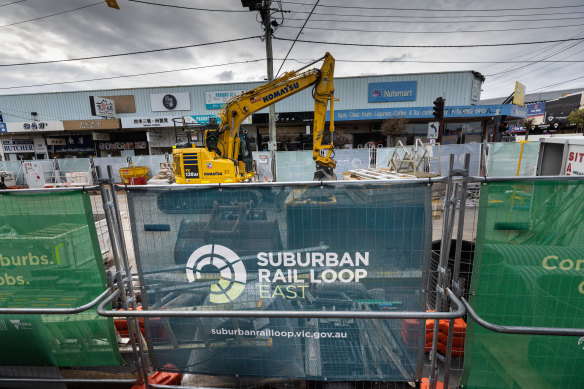This was published 1 year ago
High-rises could be needed to fill Suburban Rail Loop funding hole
High-rise apartment towers may be approved around new Suburban Rail Loop East stations to maximise developer levy revenue to help pay for the $34.5 billion project, experts believe.
The Allan government is facing a multibillion-dollar funding hole in the eastern suburbs underground train line, as the Commonwealth refuses to commit beyond Labor’s $2.2 billion federal election pledge.

The Suburban Rail Loop Authority has taken over planning controls around each new station. Credit: Jason South
Experts say the looming funding shortfall will put pressure on Victoria to permit higher development around the six stations planned between Cheltenham and Box Hill to boost revenue from “value capture” charges on commercial property sales and new residential developments.
Victoria has committed $11.8 billion to the SRL East and has previously said it expected to raise an equal one-third amount from the federal government and from value capture charges.
The government’s business case says the SRL East will open by 2035, and be the catalyst for an additional 25,000 homes in the six station “precinct” areas by 2056, compared to a scenario where the project isn’t built.
Another 21,500 additional homes are projected along the SRL North section proposed between Box Hill and Melbourne Airport. Victoria’s Housing Statement, released last month, says 80,000 new homes are needed every year over the next three decades as Melbourne grows to 8 million people and Victoria hits 10 million.
Under the business case’s projections, SRL precincts would at least double in population and employment activity by 2056, making Burwood as dense as Carlton North is today, Glen Waverley similar to Balaclava, and Clayton like Collingwood.
But planning expert Roz Hansen said the current plan was “not overly aspirational” given the demand for new housing and the fact Melbourne was starting from a point of very low-density suburbs.
Hansen said she would support greater development in SRL precincts to have more Melburnians living close to public transport, jobs and services. Doing so would also raise more revenue to cover construction costs, she said.
“What we should be trying to do is get as many homes as possible — that are still liveable and sustainable — in these locations,” Hansen said. “The more dwellings that you can get in there or development you can get in there, then the more money you’re going to be able to cross-subsidise into the infrastructure project.”
The SRL Authority has taken over planning control within 1.6 kilometres of each new SRL station — an area almost six times larger than the Melbourne CBD — and is currently holding consultations on how each precinct should be developed.
RMIT University professor of planning and environment Michael Buxton said the housing growth projections in the SRL business case were “ludicrously low”, and predicted the government would end up approving high-rise towers just to raise the revenue it needed to fund the project.
“They want as many people as possible in these precincts and they want the rezoning processes to lead to as much increased value as they can, so that encourages high-rise buildings and much lower amenity,” he said.
“Value uplift is good in principle. [But] when you let the desire for as much money as possible from the project drive it, then you end up with terribly low-quality precincts and that’s what we’re heading for. It’s a perfect disaster.”
Buxton said he did not support the project, but that if it did go ahead, the precincts should be redeveloped with European-style, high-density mixed use areas with high livability. “We’ve adopted the model that this can only be done with high-rises,” he said.
A spokesperson for the Allan government said the SRL Authority would release draft structure plans for each precinct area soon, and was still working to finalise how value capture would contribute to funding the project.
“With Melbourne’s population set to be the size of London’s by the 2050s, we can’t afford not to build this city-shaping project,” the spokesperson said.
“We are getting on with planning and consultation on how we can shape the neighbourhoods around the SRL East stations — building thousands of new homes close to world-class transport, jobs and public services.“
The state opposition’s transport infrastructure spokesman David Southwick said given the state’s financial position and uncertainty around the SRL, the government should pause the project.
“Under Labor, Victoria is broke and hardworking households and businesses are paying for Jacinta Allan’s financial waste and mismanagement,” he said.
The SRL Authority’s annual report, released earlier this month, shows its “key achievements” so far have been to move sewer and water pipes near the construction zones.
However, The Age revealed last month it is close to signing its firm tunnelling contract, which will be worth between $3 billion and $4 billion and mark the start of major construction.
SRL East is the first section of a proposed 90-kilometre loop stretching through the northern suburbs to Melbourne Airport by 2053, at an expected cost of $45 billion, and through the western suburbs to Werribee.
The Albanese government is attempting to trim $33 billion from its own infrastructure spending and launched a review into its 10-year pipeline in May which already appears to have delayed the long-awaited Melbourne Airport Rail Link, which would form part of the SRL West.
Its $2.2 billion commitment to the SRL was not included in the review, however, because it was an election promise.
The Morning Edition newsletter is our guide to the day’s most important and interesting stories, analysis and insights. Sign up here.